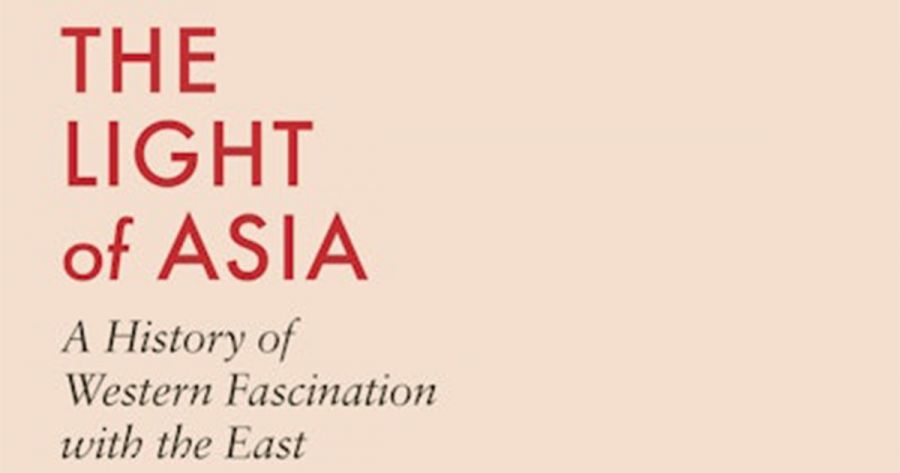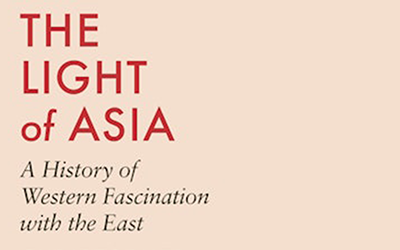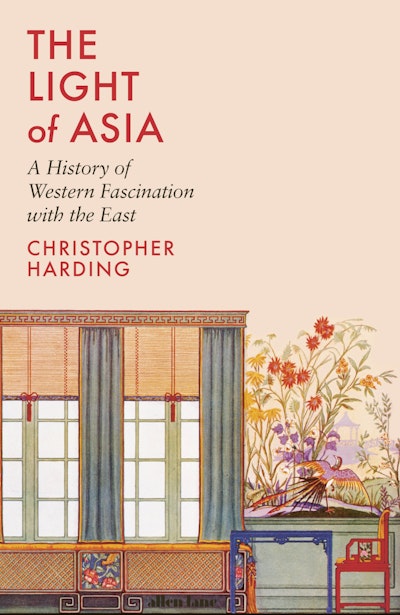
- Free Article: No
- Contents Category: Asian Studies
- Review Article: Yes
- Article Title: While men meditate
- Article Subtitle: Asiatic civilisation in the West
- Online Only: No
- Custom Highlight Text:
The world isn’t quite what it seems. We often imagine the modern world as if it were a halved orange, East clearly separated from West. For centuries, the West has claimed superiority over the Rest, despite knowing little about them, as Edward Said copiously showed in Orientalism (1978). An equally influential proposition in The Clash of Civilisations (1996) was Samuel Huntington’s. He saw the world of Islam as having ‘bloody borders’ and being pitted in conflict with the West over cultural differences. In 1984 (1949), George Orwell imagined two fictional hemispheres in conflict, Eurasia and Eastasia, leaving unresolved the problem of what to do about Oceania.
- Featured Image (400px * 250px):

- Alt Tag (Featured Image): Alison Broinowski reviews ‘The Light of Asia: A history of Western fascination with the East’ by Christopher Harding
- Book 1 Title: The Light of Asia
- Book 1 Subtitle: A history of Western fascination with the East
- Book 1 Biblio: Allen Lane, $65 hb, 463 pp
- Book 1 Cover Small (400 x 600):

- Book 1 Cover (800 x 1200):

The southern region with its many islands, including Australia, was usually seen as an inconsequential appendage. Despite calling itself a ‘Western’ country, Australia always was and remains part of the East Asian hemisphere, an Island off the Coast of Asia, as Clinton Fernandes named it (2018). In anticipating a ‘logic of one world’, former Singaporean foreign minister Kishore Mahbubani’s optimism in The Great Convergence (2014) was premature. It will take longer before such a new view of the world, with many interconnected segments, more like a geodesic soccer ball than a bisected orange, informs our belief systems and Australia’s place in it.
For centuries, the violent pursuits of Christian nations in Western Europe were recorded and read as the progressive history of ‘Western civilisation’ and its beneficial colonisation of Asia, Africa, Latin America, and the Middle East. Europeans were kept busy with successive alliances, wars, sieges, massacres, and assassinations, ignoring Christian teachings about treating one’s neighbour as oneself and loving one’s enemy. Many conflicts involved religion, including disputes with their co-believers in Eastern Europe. With lofty arrogance, fifteenth-century popes divided the known world to allow Castilians to take their flags, swords, and crosses west, while Portuguese went east. Dutch and British traders and colonisers followed, and later French, Belgians, and Germans, often appropriating whole countries.
This persistent Western belligerence could not be further from the peaceful aspirations of Buddha and Confucius in the fifth century BCE, and their millions of later followers. Buddhists revered the Five Wisdoms as their guide to a good life and after-life. Confucius’s teachings stressed high moral principles and universal virtue. From the fifteenth century, Western travellers to the ‘Indies’, whether East or West, found ancient civilisations, many impressive cities, well-fed and educated people, and leaders who were receptive to foreign technology and ideas.
As well as bringing back spices, tea, silk, lacquer, and porcelain, the travellers, traders, and missionaries – particularly those who stayed long enough to learn languages and customs – acquired cultural knowledge of Asian societies and their religious practices. Audiences at home received the travellers’ tales with rapt attention, some responding with admiration, and others with condescension. Enthusiasm for Asia waxed and waned, according to periods of rejection or acceptance of the Western travellers by their hosts. In his latest book, The Light of Asia, Christopher Harding traces the interactions, particularly of Christians, with India, China, and Japan over five centuries.
In multi-religious India, the Mughal emperor Akbar, who often discussed philosophy with Muslims, Brahmins, Jews, Jains, and Zoroastrians, invited Portuguese Jesuits to his court in Fatehpur Sikri in 1580 for a series of discussions. Akbar had trouble understanding the Trinity, miracles, and monastic monogamy, and asked how God could have a son. India for the Jesuits was not a missionary success, and the prospect of converting a leader to rival the Emperor Constantine faded. In China, however, two Italian Jesuits, Michele Ruggieri and Matteo Ricci, made a favourable impression from the 1570s with their world map, and demonstrated practical mathematics and the mechanism of clocks. Another traveller, not a missionary (so not mentioned by Harding) was Engelbert Kaempfer, a German physician who spent two years in Japan from 1690, employed by the Dutch East India Company, and collaborated with Japanese doctors who were eager for Western knowledge of medicine and surgery.
From his study of Buddhist texts, British scholar Edwin Arnold in 1879 produced a narrative poem, The Light of Asia, or The Great Renunciation, describing the life and philosophy of Prince Siddhartha Gautama, who, after attaining enlightenment, became the Buddha. Arnold’s work was translated into more than thirty languages, including Hindi. Its influence spread to Western enthusiasts who had never been to Asian countries but used them as exemplars to redress the shortcomings of their own European societies. Earlier examples of this included Voltaire, Montaigne, Montesquieu, Schelling, Coleridge, and Goethe, followed by T.S. Eliot. Harding’s eloquent survey shows how Arnold’s poem provided an influential introduction to Buddhism for Western readers, some of whom based new, occult belief systems on it. Theosophy was established in the United States in the late nineteenth century by Helena Blavatsky and her collaborators Colonel Henry Olcott and Annie Besant, who gained Swami Vivekãnanda as their figurehead: his name meant ‘bliss of discerning knowledge’. Theosophy attracted many followers, including in Australia. In the mid-twentieth century, the lure of Asia included various mind-altering substances, accompanied by exotic musical instruments, in both of which the Beatles and other performers engaged enthusiastically.
Harding begins in 1893 with the World’s Columbian Exposition in Chicago, planned to celebrate the four-hundredth anniversary of Christopher Columbus’s discovery of ‘Asia’ (although held a year late). Events included the World Parliament of Religions, listed as Shintō, Taoism, Confucianism, Buddhism, Hinduism, Jainism, Zoroastrianism, Judaism, Christianity, and Islam. To the American organisers’ surprise, Japanese and Indian guests were unconvinced by claims of the superiority of Christianity, and Vivekãnanda commented that, while Westerners were newly interested in Hinduism, they still sought ‘the exclusive survival of [their] own religion’.
For Zen proponents Shaku Sōen and D.T. Suzuki, the World Parliament was an opportunity to bring ‘Asiatic civilization’ to the West, which Shunryu Suzuki succeeded in doing at the San Francisco Zen Centre – although his successor, Richard Baker, later resigned following scandals about his use of the community’s funds and his affairs with women at the centre.
Advocates of religion in Chicago could have been challenged about the absence of women at the top of their hierarchies, Western and Asian alike. Why, for example, were yogi masters all male? British traveller Isabella Bird in the 1870s was fascinated by Japan, as was Arnold, whose third wife was Japanese, but women were excluded from the Buddhist leadership. Presumably they performed other tasks while men meditated. Harding, however, finds Western women who personally immersed themselves in aspects of spirituality in India and China: Houn Jiyu-Kennett, Erna Hoch, Sharon Salzberg, and others. He progresses – or regresses – through the ‘New Age’ 1980s and 1990s, when two Englishmen, Alan Watts and Bede Griffiths, promoted a synthesis of Asian wisdom based on long immersion in Buddhism and Taoism for Watts, and in Hinduism for Griffiths, which he combined with Christian belief and scientific modernity.
Wide as Harding’s range is, it omits Oceania entirely. Jill Roe’s Searching for the Spirit (2020) on Theosophy in Australia does not appear, nor does Judith Snodgrass’s detailed account of the Columbian exposition, Presenting Japanese Buddhism to the West (2003). Nor do David Walker’s highly relevant Anxious Nation (1999) and Stranded Nation (2019). As Western wars rage on, the question of what so much religious disputation has achieved awaits an answer.


Comments powered by CComment